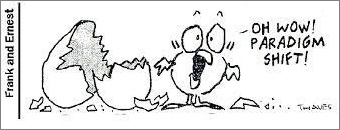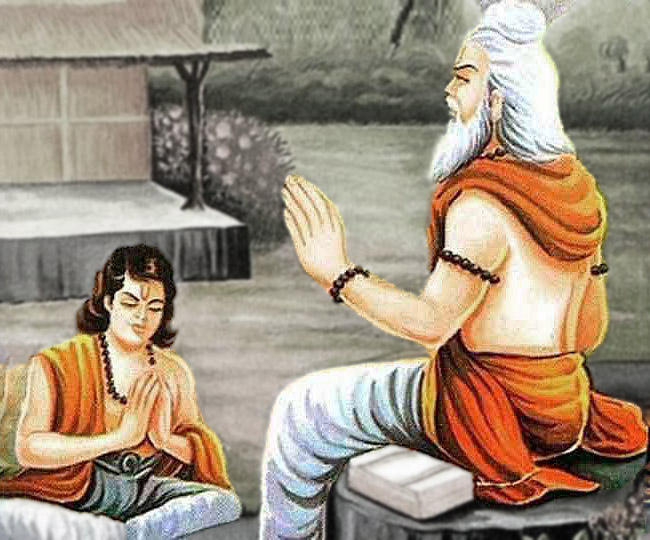Shelly: My Personal Reflections by Jeffrey Gold
Part IV: Purusha, Prakriti and the Inversion
-- yinyoga.com
For Patanjali, Purusha is untainted consciousness, the True-Self. The Conscious-Seer within. Prakriti is the physical world and even the events in the brain like thoughts, wishes, emotions, desires, plans, etc. Patanjali calls the various thought-waves in the mind chitta-vritti or mind stuff. And the practice of yoga aims to calm or still that mind-stuff. Swami Savitripriya’s commentary on Patanjali's Yoga Sutras 1:3 explains what happens when the thought-waves are calm:
Shelly's Version
 Shelly’s version of that is that the practice of Kriya Yoga enables us to reduce the number of objects of
awareness to one. At that point, the intensity x the duration of the currents of Ida = the intensity
x the duration of the currents of Pingala and they collapse into Sushumna.
Shelly’s version of that is that the practice of Kriya Yoga enables us to reduce the number of objects of
awareness to one. At that point, the intensity x the duration of the currents of Ida = the intensity
x the duration of the currents of Pingala and they collapse into Sushumna.
When that happens, we move towards Self-Awareness and find Our True Self (Purusha), though I must point out I have never heard Shelly use the word "Purusha." Shelly, like Patanjali, says that this process leads to bliss.
The key to liberation is disidentification. We normally and automatically identify with Prakriti. We identify with our bodies (I am handsome, or I am black or I am disabled.) We identify with our personalities (I am a free-spirit, I am a seeker, I am a happy person, I am a sad person, I am an introvert). We identify with our careers and roles in life (I am a mother, I am a doctor, I am a football player). We may identify with our astrological chart (I am a Scorpio with a T-Square, I am Neptunian, I am in higher education because I have lots of planets in the 9th house). The list is virtually infinite. In Yoga, the path to liberation (Kaivalya is the term Patanjali uses) is to disidentify with Prakriti and identify with Purusha.
Phishing
 Just as a
fisherman tries to hook a fish with a tasty treat that lures a fish, or a drug dealer tries to hook a
potential addict with an incredible high, or Fan Duel tries to hook
the public on the thrill of winning a fortune, or a porn site tries to hook a customer with guilty pleasure,
scammers practice a technique called phishing.
Just as a
fisherman tries to hook a fish with a tasty treat that lures a fish, or a drug dealer tries to hook a
potential addict with an incredible high, or Fan Duel tries to hook
the public on the thrill of winning a fortune, or a porn site tries to hook a customer with guilty pleasure,
scammers practice a technique called phishing.
Phishing is an activity whereby attackers send malicious emails designed to trick people into falling for a con. The email often looks authentic and tries to convince the mark that he or she must do something (like click on a link) to avoid disaster. However, if we fall for it, we end up inviting disaster. Fishermen try to trick fish with bait (something pleasurable to the fish) as a means of eating the unsuspecting fish. The same is true with drug dealers, betting sites, and porn sites. They try to trick the unsuspecting public by offering something pleasurable that is, in reality, toxic or harmful.
Internal Phishing
The insight of Yoga is that not all scammers are external. Many of the agitations of the mind (chitta-vritti) act like scammers by engaging in what I will call an internal phishing operation. Everything wants to live. Not only creatures and animals want to live but psychological entities and processes want to live. Thoughts and emotions want to live. What is it for a thought or emotion to remain alive? It lives through being noticed or brought to attention. A forgotten thought to which we no longer pay attention has, in a sense, died. Thoughts of revenge, anger, jealousy, etc. continue to live as we continue to entertain them or contemplate them or engage with them. They are our children who thrive off attention. Toxic thoughts don’t care that they are toxic. They don’t care if they harm you. They just want to survive and multiply. In that way, they resemble viruses. The Covid virus wants to live and multiply and couldn’t care less what it does to the host.
We could even call poisonous thoughts and emotions "mind viruses". These mind viruses compete for our attention. As we identify with violent thoughts, we feed them. The more we feed our anger, the angrier we get and the angrier we get, the more we feed it. It’s a vicious cycle. If we were to recognize that anger and jealousy and hatred and other toxic psychological states are sophisticated scam artists who offer us the forbidden fruit of schadenfreude (pleasure at the pain of others) at an enormous cost, we might begin to disidentify with them. After years of disidentifaction practice, we learn to no long feed them with our attention and they become calmer and stiller. A savage bear becomes a teddy bear. Disidentification is the meditative equivalent of putting a scam email in the junk folder. It is still there but it has lost its potency.
Shelly's Perspective
I will now return to Shelly’s teachings in search of a connection.
- For Shelly, when we meditate properly, we reduce the number of objects of awareness.
- When the number of objects of awareness approaches or reaches one, we find ourselves (Purusha).
 When we
find ourselves, it is the experience of standing off and viewing ourselves and it is unclear whether we
are the viewer or the viewed (whether we are Purusha or Prakriti). Am I Self-Conscious
Awareness or am I professor, father, husband, etc.? Who is viewing whom? An inversion occurs.
When we
find ourselves, it is the experience of standing off and viewing ourselves and it is unclear whether we
are the viewer or the viewed (whether we are Purusha or Prakriti). Am I Self-Conscious
Awareness or am I professor, father, husband, etc.? Who is viewing whom? An inversion occurs.
My interpretation of this (and it is just my interpretation) is that we experience the following flip: we stop identifying with Prakriti (our personality, our nationality, our religion, our astrological sign) and begin to identify with Purusha. So, I AM AWARE THAT I AM is more like I AM AWARE THAT I AM PURE CONSCIOUSNESS or Purusha. I no longer identify with my personality, my religion, my career, etc. Shelly never puts it this way, this is simply how I try to make sense out of Shelly’s inversion. And so, and I want to emphasize this, I may be wrong about this.
- As a result of the inversion, the power of our meditation increases and we approach God Consciousness. In this state, we experience "bliss" and "the peace that surpasses all understanding."
To expand upon this, I have added the term disidentify to help me understand Shelly’s system. Shelly plainly says that Self Conscious Awareness can be stated as I AM AWARE THAT I AM. But in Shelly’s view, when we find ourselves in meditation, we don’t know if we are the meditator or the object of meditation.
My interpretation of that is that we don’t know if we are Purusha or Prakriti (or, to put it more simply, we don’t know if we are the roles we play (teacher, truck driver, model, Trump-supporter, free spirit, etc.) or if we are simply conscious awareness. Since, in our normal waking consciousness, we identify with our personality and character traits, when the inversion takes place, I propose that we cease to identify as Republicans, Democrats, Comedians, or Opera singers and simply identify as Pure Consciousness or Balanced Self-Conscious Awareness. So, to make a long story short, the inversion is a flip in what we identify with.
Paradigm Shift
David Foster Wallace, in his famous commencement speech to the graduating class of 2005 at Kenyon College said:
This is how we look at the world prior to the inversion. When David Foster Wallace is speaking of self-centeredness, he is speaking of us when we identify with our roles (Prakriti). Jeff, who identifies as a home-owner, is angry that the Homeowners Association raised their fees while reducing their services. Frank, who identifies as a Cleveland Browns fan, is upset that the Browns have never gone to the Super Bowl.
The philosopher of science Thomas Kuhn introduced the term paradigm shift into the mainstream in 1962. A paradigm shift is defined as "an important change that happens when the usual way of thinking about or doing something is replaced by a new and different way."
Classic examples of paradigm shifts include the shift from Ptolemy to Copernicus in Astronomy or Newton to Einstein in Physics. It is a radical, dramatic change in which we see things differently. After the shift, we see things in an entirely new light or from an entirely different perspective. In our normal lives, we see the world through the lens of ego or self. For each of us, we are the center of our worlds. The inversion, the switch to what Shelly calls God Consciousness, is one of these radical dramatic shifts. We no longer see the world from our limited self.

This is a particularly appropriate image of a Shelly-like inversion or paradigm shift: in many Asian
philosophies, the ego is portrayed as a shell or a cage or a prison cell. On the one hand, it protects us,
but on the other hand it limits or confines us. I am proposing that Shelly’s inversion is something like the
paradigm shift of breaking out of our shells. The shells keep us locked in our limited perspective (I am a
teacher, an American, A Liberal, Protestant, a Fox News enthusiast, etc.) and opens us up to, for lack of a
better term "a view from infinity" or sub specie aeternitatis. Sub specie aeternitatis means "from
the perspective of eternity". Ordinarily, we identify with Prakriti, but in Shelly’s inversion, we
see the world from the perspective of God Consciousness or Purusha where "consciousness remains established in and identified with Its own Eternal, Undiluted, Blissful Essence".
Once Upon a Time
Shelly tells the following story:
 Once a guru in India had a cancer growing on
his body. His disciples became very concerned and expressed that concern to the guru and asked "When you go into God-Consciousness, could you cure the cancer?" And the guru
said yes. So, the disciples begged him to do it. The guru would meditate again and again and the cancer kept
getting worse. Finally, in desperation, the disciples said: "Master, you say that when you are in God consciousness, you could cure the cancer but nothing ever happens."
The guru responded: "I know but when I am in God Consciousness, I don’t have no problems, so I never think to ask."
But upon further pleading from the disciples, finally, as he was coming out of God Consciousness, the guru
said "Please, for the sake of my disciples, cure this cancer." And when the guru
ceased his meditation, the cancer was gone.
Once a guru in India had a cancer growing on
his body. His disciples became very concerned and expressed that concern to the guru and asked "When you go into God-Consciousness, could you cure the cancer?" And the guru
said yes. So, the disciples begged him to do it. The guru would meditate again and again and the cancer kept
getting worse. Finally, in desperation, the disciples said: "Master, you say that when you are in God consciousness, you could cure the cancer but nothing ever happens."
The guru responded: "I know but when I am in God Consciousness, I don’t have no problems, so I never think to ask."
But upon further pleading from the disciples, finally, as he was coming out of God Consciousness, the guru
said "Please, for the sake of my disciples, cure this cancer." And when the guru
ceased his meditation, the cancer was gone.
For Shelly, the important point of the story is that the wish was granted because it was grounded in unselfish love. Had he asked for his own sake, the wish would not have been granted, but since he said "for the sake of my disciples..." the cancer disappeared. Clearly, that is the main point of the story. But another part that captures my attention is when the guru says "when I am in God Consciousness, I don’t have no problems, so I never think to ask." In my trying to put things together, I see that in God Consciousness, the inversion has taken place. The guru is no longer identifying with his cancer-inflicted body but only with Self-Conscious Awareness. Self-Conscious Awareness doesn’t have cancer so "I don’t have no problems."
The Inversion
To bring this to a close, Yogis call the material world Prakriti. The material world, in Yoga, includes the brain, brain states and processes including thoughts, ideas, plans, goals, etc. So, the Yoga teachings can acknowledge that material objects can think. Computers can think, calculate, write papers, express opinions, play chess, etc. But, computers are not Conscious in the way in which we are. They are incapable of Self-Conscious Awareness. They lack the ability to be aware that they are. Humans have that ability and Patanjali calls Consciousness Purusha. For Patanjali, when we dwell in and identify with Purusha, we find ourselves and experience bliss. Shelly speaks of this as an inversion. I interpret Shelly’s inversion as an event in which we see things from the perspective of Eternity or Purusha and no longer see the world through the lens of ego.